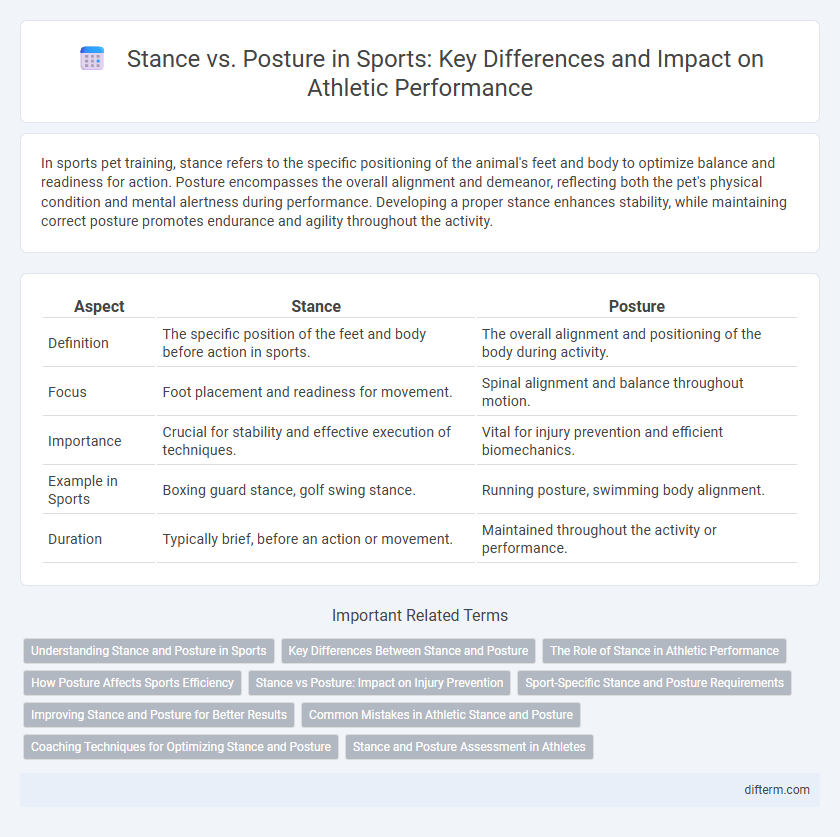In sports pet training, stance refers to the specific positioning of the animal's feet and body to optimize balance and readiness for action. Posture encompasses the overall alignment and demeanor, reflecting both the pet's physical condition and mental alertness during performance. Developing a proper stance enhances stability, while maintaining correct posture promotes endurance and agility throughout the activity.
Table of Comparison
| Aspect | Stance | Posture |
|---|---|---|
| Definition | The specific position of the feet and body before action in sports. | The overall alignment and positioning of the body during activity. |
| Focus | Foot placement and readiness for movement. | Spinal alignment and balance throughout motion. |
| Importance | Crucial for stability and effective execution of techniques. | Vital for injury prevention and efficient biomechanics. |
| Example in Sports | Boxing guard stance, golf swing stance. | Running posture, swimming body alignment. |
| Duration | Typically brief, before an action or movement. | Maintained throughout the activity or performance. |
Understanding Stance and Posture in Sports
Stance in sports refers to the athlete's initial body position that provides balance and readiness for movement, while posture involves the alignment and positioning of the body during activity to optimize performance and prevent injury. Effective stance ensures stability and power generation, crucial in sports such as baseball, golf, and martial arts. Proper posture maintains biomechanical efficiency, enhances agility, and supports endurance across various athletic disciplines.
Key Differences Between Stance and Posture
Stance refers to the specific positioning of the feet and body that provides balance and readiness for movement in sports, while posture involves the overall alignment and positioning of the body that affects performance and injury prevention. Key differences include that stance is primarily concerned with base support and stability tailored to particular sports actions, whereas posture encompasses the entire body's structural alignment during both dynamic and static activities. Optimal stance enhances agility and power generation, whereas proper posture promotes endurance and reduces the risk of musculoskeletal strain.
The Role of Stance in Athletic Performance
An athlete's stance is foundational for balance, power generation, and movement efficiency, directly influencing overall performance. Proper stance aligns the body's center of gravity to maximize stability and readiness for dynamic actions. Optimizing stance improves reaction time and energy transfer, essential for peak athletic execution.
How Posture Affects Sports Efficiency
Optimal posture enhances sports efficiency by improving balance, alignment, and muscle engagement during movement. Proper posture reduces the risk of injury by distributing physical stress evenly across the body, enabling athletes to maintain endurance and power. Efficient posture also facilitates better breathing and coordination, critical factors for peak athletic performance in sports like running, swimming, and cycling.
Stance vs Posture: Impact on Injury Prevention
A proper stance provides a stable foundation that enhances balance and reduces the risk of acute injuries during dynamic sports movements. In contrast, maintaining correct posture supports optimal alignment and muscle engagement, minimizing the likelihood of chronic strain and overuse injuries over time. Athletes who prioritize both stance and posture benefit from improved biomechanics, leading to superior injury prevention outcomes.
Sport-Specific Stance and Posture Requirements
Sport-specific stance and posture requirements vary significantly across disciplines, optimizing performance and reducing the risk of injury. In golf, a low, balanced stance with slightly bent knees enables precise swing mechanics, while in basketball, a flexible, slightly crouched posture facilitates quick lateral movements and explosive jumps. Athletic training protocols emphasize adapting stance and posture to the unique biomechanical demands of each sport for enhanced efficiency and control.
Improving Stance and Posture for Better Results
Improving stance and posture enhances athletic performance by promoting balance, stability, and efficient movement patterns essential in sports like basketball, golf, and running. Proper stance aligns the body's center of gravity, reduces injury risk, and maximizes force generation during physical activity. Consistent practice of correct posture supports muscle engagement and endurance, leading to better results and faster recovery in training and competition.
Common Mistakes in Athletic Stance and Posture
Common mistakes in athletic stance and posture include improper weight distribution, such as leaning too far forward or backward, which reduces balance and reaction time. Athletes often fail to align their joints correctly, leading to inefficient movement patterns and increased injury risk. Neglecting core engagement results in poor stability, negatively impacting overall performance and endurance during sports activities.
Coaching Techniques for Optimizing Stance and Posture
Coaching techniques for optimizing stance and posture emphasize precise body alignment and weight distribution to enhance athletic performance and prevent injuries. Utilizing video analysis and real-time feedback allows coaches to identify biomechanical inefficiencies and make data-driven adjustments tailored to individual athletes. Consistent drills targeting core strength and proprioception further reinforce optimal stance and posture, improving balance and power across various sports disciplines.
Stance and Posture Assessment in Athletes
Stance and posture assessment in athletes is crucial for optimizing performance and preventing injuries, as proper alignment influences balance, power generation, and movement efficiency. Evaluating stance involves analyzing foot positioning, weight distribution, and joint angles, while posture assessment focuses on spinal alignment and muscle symmetry during dynamic and static activities. Accurate assessment tools like motion capture systems and pressure sensors provide detailed data to tailor training programs and correct biomechanical imbalances.
stance vs posture Infographic

 difterm.com
difterm.com